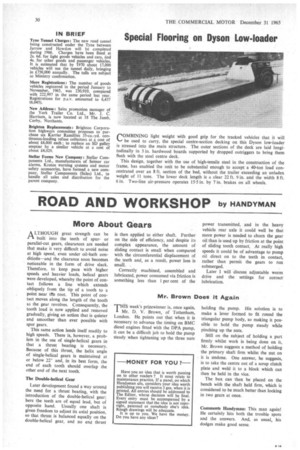ROAD AND WORKSHOP by HANDYMAN
Page 32

If you've noticed an error in this article please click here to report it so we can fix it.
More About Gears
LTHOUGH great strength can be r-k built into the teeth of spuror parallel-cut gears, clearances are needed that make it very difficult to avoid noise at high speed, even under oil-bath conditions—and the clearance soon becomes noticeable in the form of drive slack. Therefore, to keep pace with higher speeds and heavier loads, helical gears were developed, whereby the point of contact follows a line which extends obliquely from the tip of a tooth to a point near die root. This point of contact moves along the length of the tooth as the gear revolves. Consequently, the tooth load is now applied and removed gradually, giving an action that is quieter and smoother than ever possible with spur gears.
This same action lends itself readily to high speeds. There is, however, a problem in the use of single-helical gears in that a thrust bearing is necessary. Because of this thrust, the helix angle of single-helical gears is maintained at or below 22° and, in its best form, the end of each tooth should overlap the other end of the next tooth.
The Double-helical Gear Later development found a way around the need for a thrust bearing, with the introduction of the double-helical gear; here the teeth are of equal lead, but of opposite hand. Usually one shaft is given freedom to adjust its axial position, so that thrust is balanced equally on the double-helical gear, and no end thrust is then applied to either shaft. Further on the side of efficiency, and despite its complex appearance, the amount of sliding contact is small when compared with the circumferential displacement of the teeth and, as a result, power loss is small.
Correctly machined, assembled and lubricated, power consumed via friction is something less than 1 per cent of the
power transmitted, and in the heavy vehicle rear axle it could well be that more power is needed to churn the gear oil than is used up by friction at the point of sliding tooth contact. At really high speeds it could be of advantage to pump oil direct on to the teeth in contact, rather than permit the gears to run submerged.
Later I will discuss adjustable worm drive and the settings for correct' lubrication.




















































































